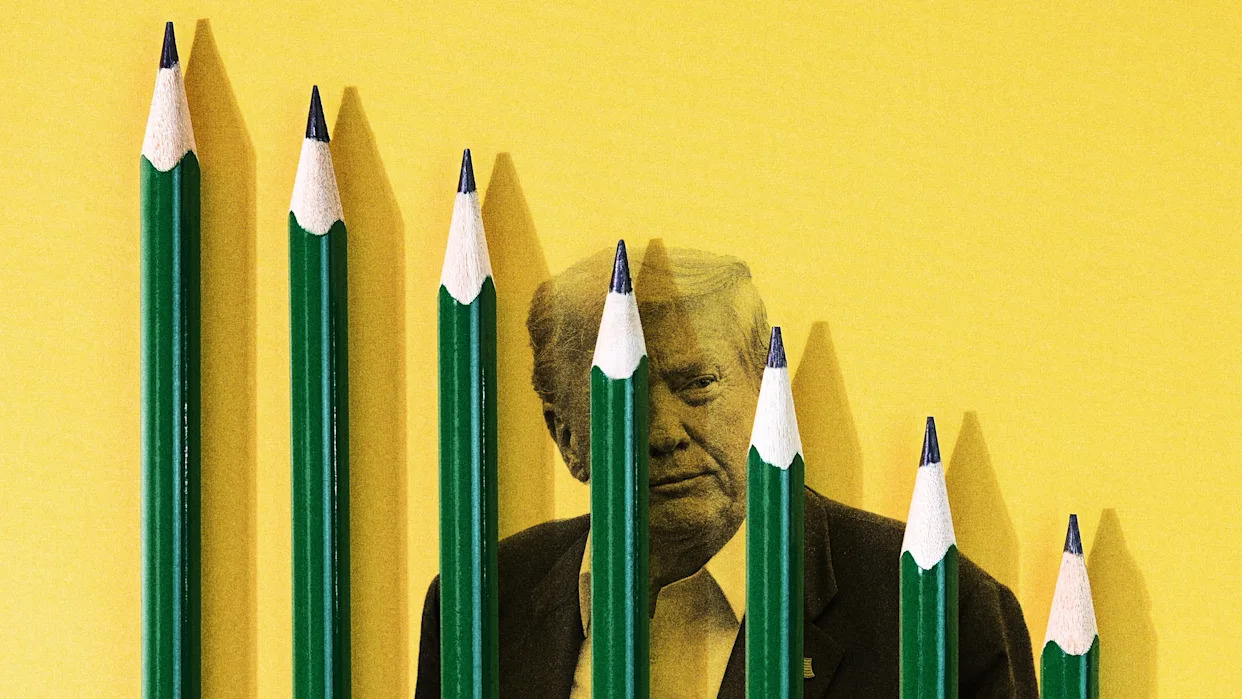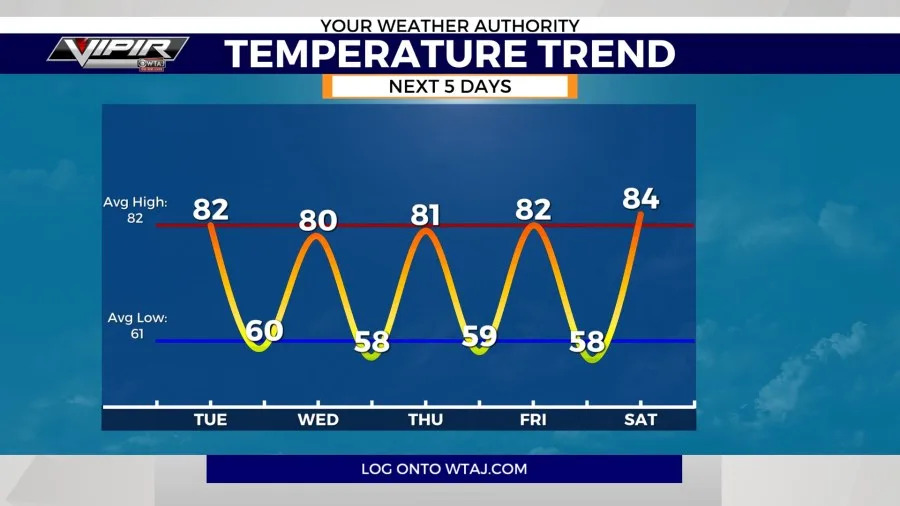
The Atlantic Daily, a newsletter that guides you through the biggest stories of the day, helps you discover new ideas, and recommends the best in culture. Sign up for it here.
The email arrived at 10:55 p.m. on Friday, July 25, with an upbeat subject line: “Big News: Key Federal Title Funds Set to Release Next Week.” It was sent by North Dakota’s schools superintendent, Kirsten Baesler, who is awaiting confirmation to become an assistant secretary at the U.S. Department of Education, the very agency that had been holding back the funds in question—more than $5 billion—from school districts for weeks.
“Thank you for your advocacy, patience, professionalism, and persistence as we’ve waited for these essential funds to flow,” Baesler wrote to local school leaders. Like their peers across the country, North Dakota educators had grown dismayed as the congressionally approved money, one of the largest federal-grant programs for K–12 students, had been held up. Some had spent the summer pondering layoffs and sweating over spreadsheets. “Hopefully, this development will provide greater clarity as you move forward with budget planning for the upcoming year,” Baesler reassured them. She signed the message, “With relief and gratitude.”
That an incoming official of the Department of Education was touting the importance of federal dollars for a heavily Republican state underscores the conundrum that President Donald Trump faces in his attempt to dismantle the agency. On the campaign trail, Trump’s promise to “send education back to the states” was often greeted with applause, and the Supreme Court has allowed the president to go ahead with his plans to gut the Education Department. But the four-week funding freeze—and the backlash it sparked—showed that cutting popular programs for schoolkids can be as unwelcome in Trump country as it is in coastal cities.
[Quinta Jurecic: The Supreme Court won’t explain itself]
“After months of being told to ‘wait it out,’ districts are now supposed to pick up the pieces and act like everything’s fine,” Steven Johnson, the superintendent of Fort Ransom School District, in southeastern North Dakota, told me. “I’ve got to be honest—this doesn’t sit well out here. You can’t freeze money that was already allocated, leave schools hanging through hiring season and budget planning, and then expect us to just be grateful when it finally shows up. Rural folks don’t like being jerked around.”
While the funds were frozen, an informal alliance emerged between rural and big-city educators who pushed back against the president. Lawmakers from some of the reddest parts of the country opposed the funding pause too, an early warning signal to the White House as it weighs plans that might further disrupt the public-education system.
If the Trump administration’s decision to abruptly cut off the funding began as a trial balloon, it ended as a cautionary tale.
In arguing for the dismantling of the Education Department, Trump has asserted that America’s schoolchildren have fallen further behind their global peers since the department’s creation, in 1979. This is correct, but his proposed solution of sending education “back to the states” has always been a bit misleading. The federal government accounts for only about 10 percent of K–12 funding; states and localities cover the bulk of the cost. Still, the money that the administration withheld last month—which initially totaled about $6.8 billion—is significant. It represents more than 7.5 percent of the Education Department’s current budget. The funds pay for after-school programs, teacher training, English-learner services, migrant-education grants, and STEM activities. Many schools rely on the money to pay educators and run summer programs.
Educators across the country first learned on June 30 that the money was being frozen, just hours before it was supposed to be released. In a three-sentence email, the Department of Education told states that it was withholding the funds to conduct a review, “given the change in Administrations.” The unsigned message came from [email protected] and offered no details on what the review entailed, how long it would take, or whether the money would ultimately be released. The closest thing to an explanation came from the Office of Management and Budget, which asserted in a statement that the funds had previously been used to “subsidize a radical left-wing agenda,” support LGBTQ programming, and “promote illegal immigrant advocacy.”
Schools immediately began to feel the impact of the missing funds. In Cincinnati, administrators were forced to cancel orders for new curriculum materials and pause some services for students learning English. Some teachers in Fargo, North Dakota, learned that their annual $500 bonus was abruptly being cut. Officials in California, which had been expecting almost $1 billion from the federal funds, abruptly paused operations for a teacher-training program.
Back-to-school planning was affected too. In the nation’s second-largest school district, Los Angeles, officials braced for “impossible choices” such as potentially having to shut down after-school tutoring or lay off school counselors, the district’s superintendent, Alberto Carvalho, told me. “For us to organize and budget and prepare for a school year impacting 540,000 students—in addition to 70,000 adult learners—we need to know what our recurring revenues are,” he said. Johnson, whose hometown of Fort Ransom, North Dakota, has a population of 2,200 and is 70 miles from the nearest Walmart, made the same case when he spoke with me from his cattle ranch. “If we don’t hire staff between such-and-such a date, we’re not going to get them,” he told me. “So the delay tactics already have hurt.” In a survey conducted last month by the School Superintendents Association, a group that advocates for more federal support for K–12 education, hundreds of school-district leaders from across the country similarly reported that they were planning to lay off teachers and cut classroom programs if the hold on funds persisted into August.
[David A. Graham: What does the Department of Education actually do?]
In Washington, lawmakers from both parties began to relay these concerns to the White House. In a July 16 letter to OMB Director Russell Vought, Senator Shelley Moore Capito of West Virginia joined nine other Republican senators—including lawmakers from six of the 10 states Trump carried by the largest margins in November—to urge the administration to release the money immediately. The senators noted that Congress had already approved the funding as part of a spending law and called on the administration to “faithfully implement” that legislation. “Withholding these funds will harm students, families and local economies,” the senators wrote. Senator Tommy Tuberville of Alabama did not sign the letter but told reporters on July 17 that he planned to talk with Trump about the funds during a dinner that was planned for the following day. (I asked Tuberville’s office if the senator had gone through with the conversation but didn’t get a response.)
Meanwhile, local and state officials from across the demographic and political spectrum banded together to advocate for the funding’s release. On July 21, a group that included school districts and teachers’ unions filed a joint lawsuit challenging the halt in funding. Among the plaintiffs were the Kuspuk School District, in remote Alaska, which has about 300 students spread out over 12,000 square miles, as well as Cincinnati Public Schools, which has 35,000 students in about 80 square miles. “They do not want to spend their time suing the federal government,” the lawsuit said of the schools. “They want to do their jobs serving students and communities.” (The case is pending.)
That same day, the Department of Education released part of the funding—$1.4 billion for “21st Century Community Learning Centers” grants, which high-poverty states such as West Virginia disproportionately rely on for after-school and summer-school programs. A few days later, on July 25, the department said it would release the more than $5 billion in remaining funds. Federal officials offered no public accounting of what their review had turned up, but they threatened further scrutiny of school districts that ran afoul of federal civil-rights laws and presidential directives. The Trump administration has used civil-rights legislation to go after schools for policies regarding transgender athletes and diversity, equity, and inclusion.
The White House and the Education Department did not respond to requests for comment about the funds. Speaking at a National Governors Association meeting on the day the funds were released, Education Secretary Linda McMahon said the federal government was “well satisfied” after evaluating the grant programs under review and that she expected dollars to flow more seamlessly in the future.
Although OMB officials had initially attempted to cast the review as part of Trump’s effort to root out liberal ideology from schools, Jon Valant, who researches K–12 policy at the Brookings Institution, told me that the White House was never likely to find much evidence to back up those claims. “When you have a country with millions of public-school teachers across about 100,000 public schools, if you look, sure, you’re going to find someone somewhere who’s doing something objectionable,” he said. “But the vast majority of these funds are used in ways that hardly any American would object to.”
Ed Hermes, a school-board member in Phoenix, echoed this. “This is going to Girl Scouts. This is going to softball. I know because my kids are in these programs,” Hermes, a former schoolteacher himself, told me. “This is going to fund kids getting help with their math homework after school.”
The decision to hold back the congressionally mandated funding came as the Education Department has lost nearly half its workforce under Trump, who is proposing additional budget cuts for the agency. The White House has asked Congress to slash grants for migrant education, English-language acquisition, and other programs funded by the money that was recently frozen, as part of next year’s budget.
If she is confirmed by the Senate, Baesler, the North Dakota superintendent, could soon join that effort as the next assistant secretary for elementary and secondary education. Whether she will use her new perch to contribute to the Trump administration’s goal of shutting down the department or advocate on behalf of schools that rely on federal funds is a question of great concern to educators in her home state. Wayne Trottier, who retired in June as superintendent of the school district in Sawyer, North Dakota (population 307), told me that he’d recently confronted Baesler about the funding freeze. Trottier said that he’d asked her whether she would fight from the inside against the Trump administration’s cuts. “This is why the Department of Education needs me on staff now and not later,” he recalled her saying.
Baesler did not respond to my requests for comment. In an email to superintendents yesterday, she said she was “pleased” to announce that the dollars were now available, and thanked McMahon, North Dakota lawmakers, and local educators “who advocated for the release of these funds.”
[Kevin Carey: Scammers are coming for college students]
She could have a tough time in Washington making the case for Trump’s proposed cuts. On Thursday, a bipartisan group of lawmakers on the Senate Appropriations Committee passed a spending bill that rejected Trump’s plan to scale down the Education Department. The bill also included language essentially banning the Trump administration from pursuing another funding freeze for K–12 schools next year. It passed by a 26–3 margin and now heads to the full Senate for a vote.
The Trump administration could also continue to face resistance from around the country. In my conversations with school officials from both urban and rural districts, I frequently heard them making the case for each other. Johnson, who serves on the board of the National Rural Education Association, which advocates for schools in remote areas, stressed the crucial role the department plays in defending the civil rights of minority students and immigrants—of which there are few in his town. “Why are they picking on the Hispanics?” he said at one point. Luisa Santos, who serves on the school board in Florida’s large and very diverse Miami-Dade County, told me that without the Education Department, smaller districts would struggle the most. “The federal government is able to support extremely rural areas—areas that, frankly, I don’t think could generate that funding on their own if they needed to,” she said.
This urban-rural alliance could be tested, however, as Trump aims to move forward with his broader education agenda, which includes advancing school-choice vouchers, filing lawsuits against schools over transgender policies, and promoting what the White House has called “patriotic education.” Some educators I spoke with feared that long-standing cultural divides over immigration, race, gender, sexuality, and how to teach American history could create fissures among school districts that have found common cause in advocating for broadly popular programs such as summer school.
The administration’s decision to end the funding freeze, these sources said, could ultimately be a tactical retreat ahead of a more aggressive push to demolish the Department of Education. “It’s a half-sigh of relief,” Santos said about the release of federal funds, adding that a “roller coaster of unknowns” still awaits educators as the new school year begins. “I don’t think this is the end at all.”








Comments